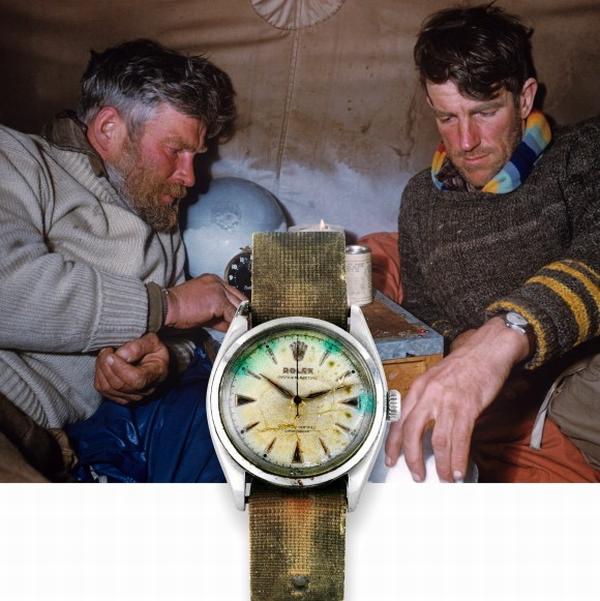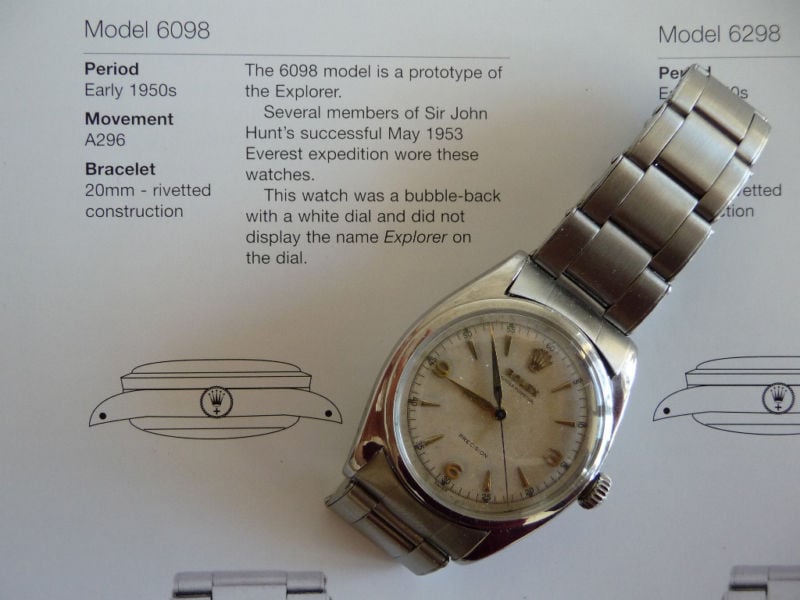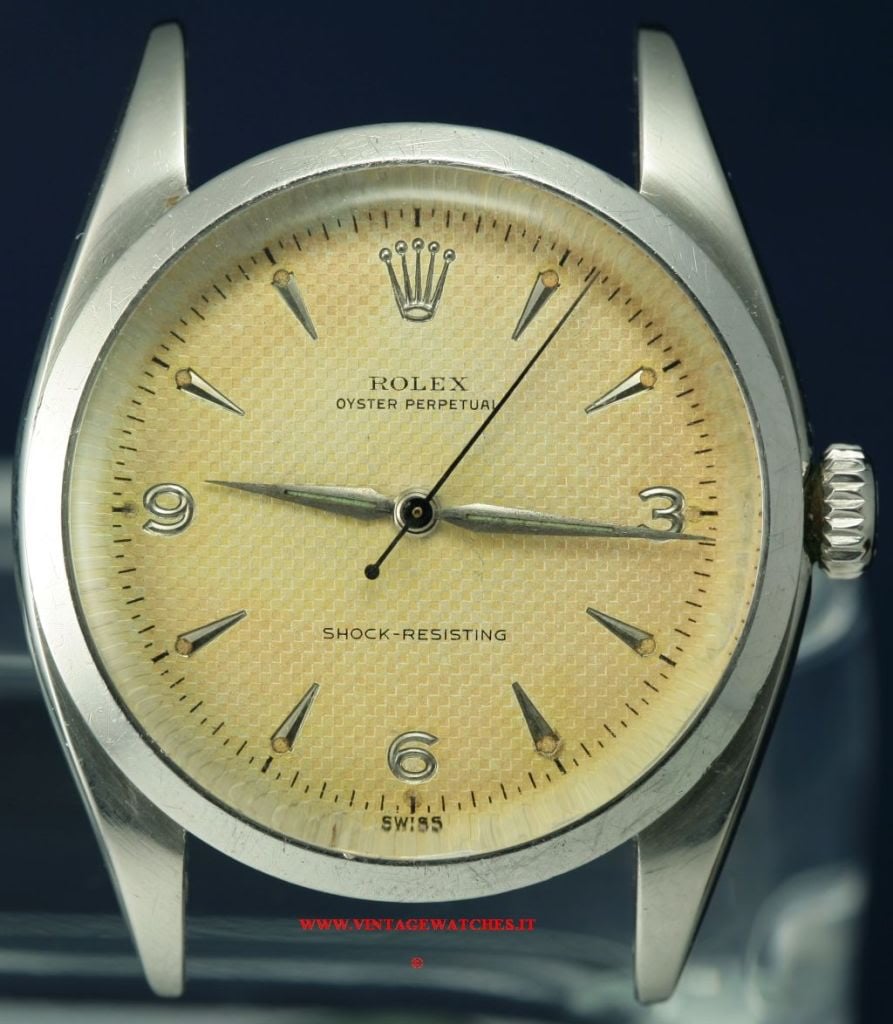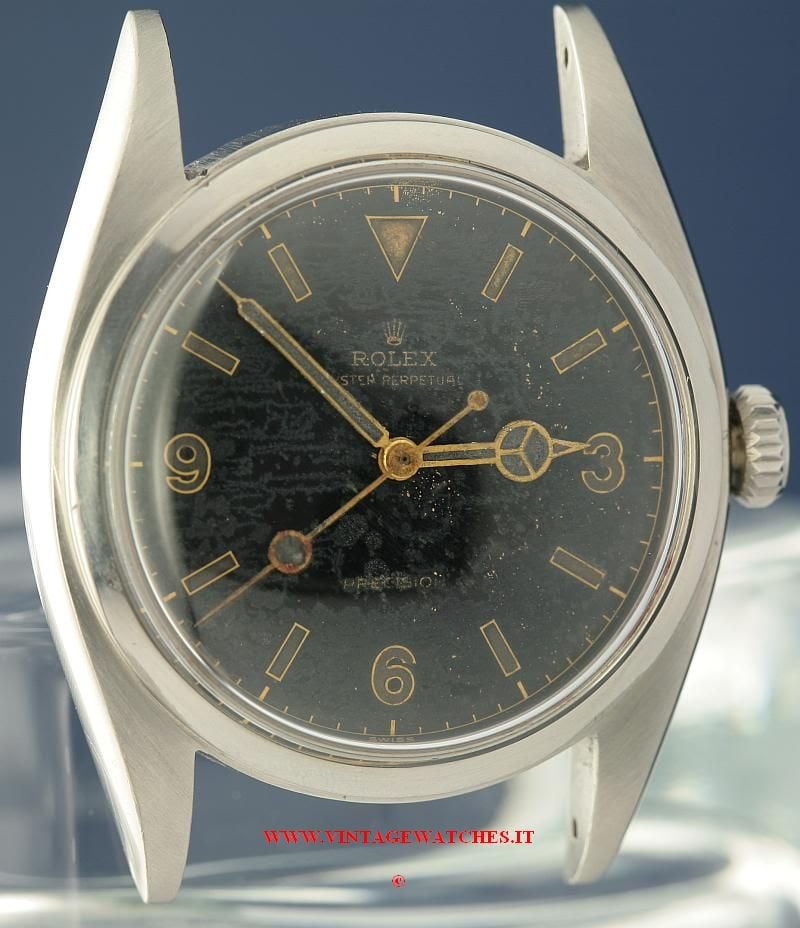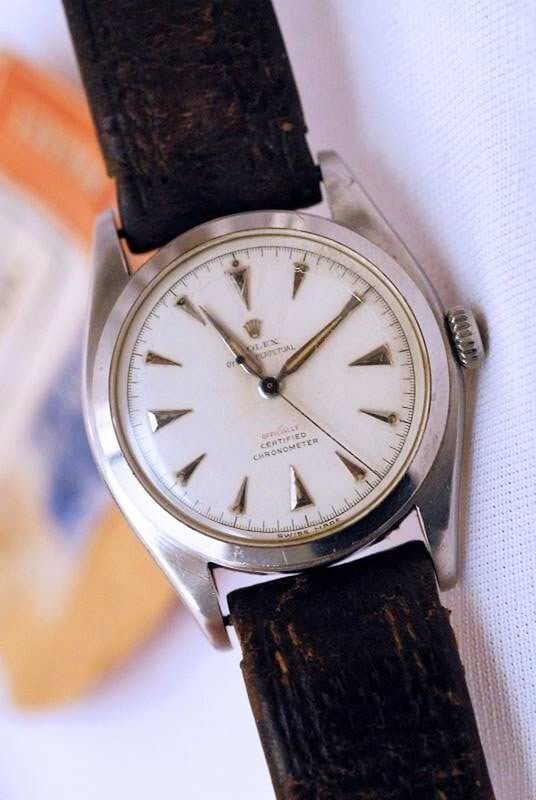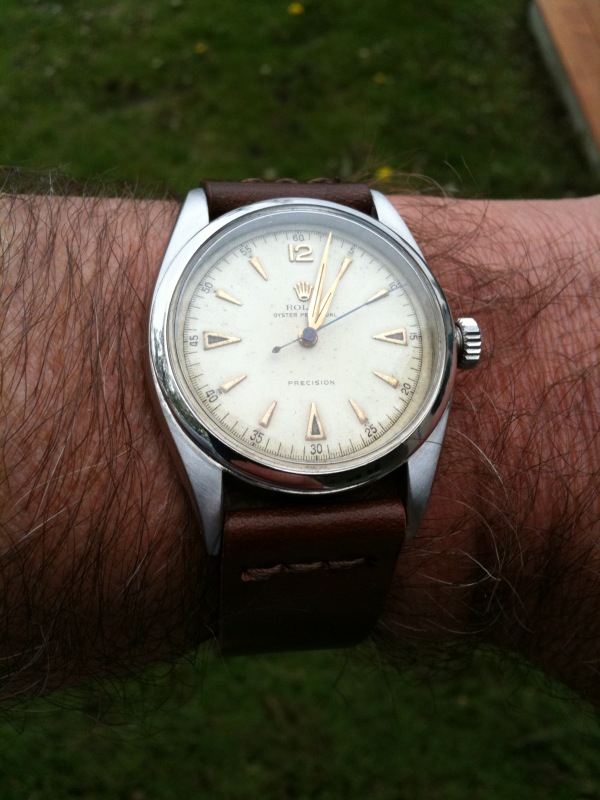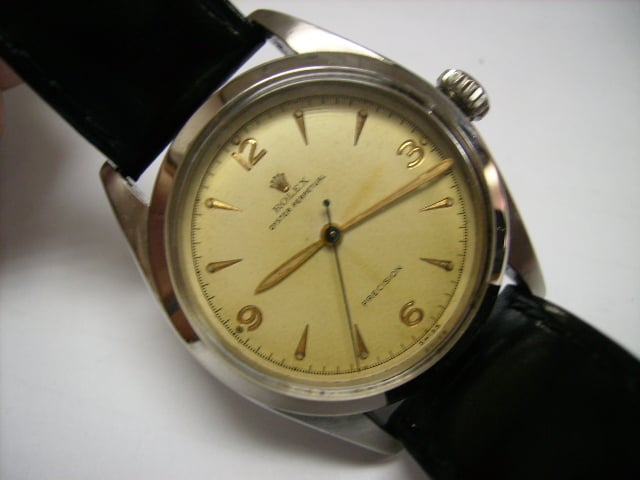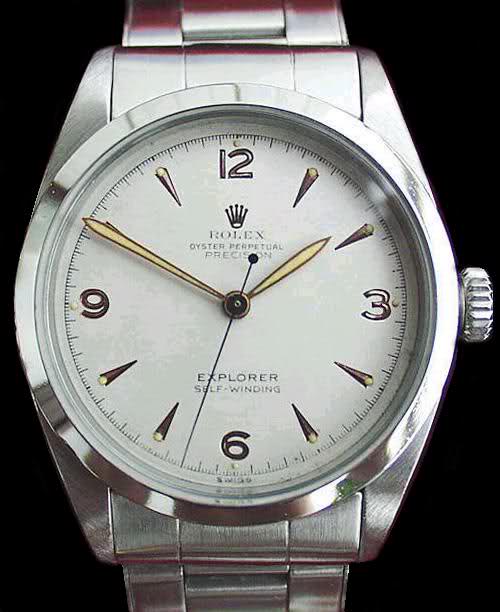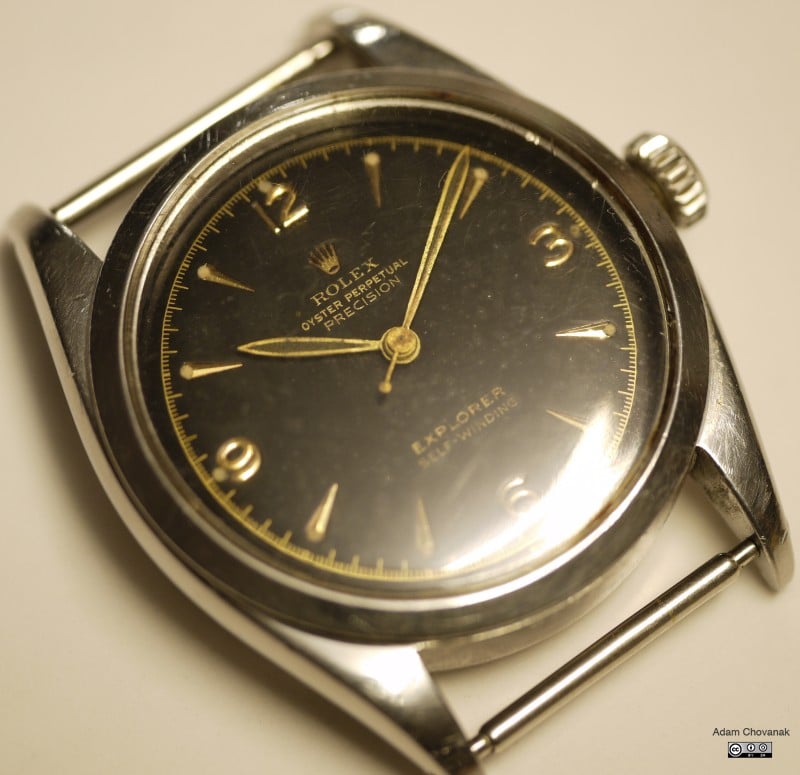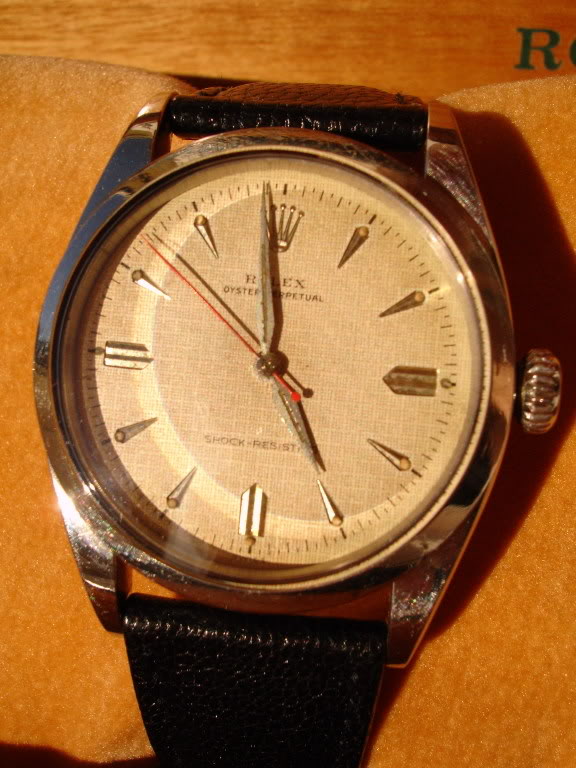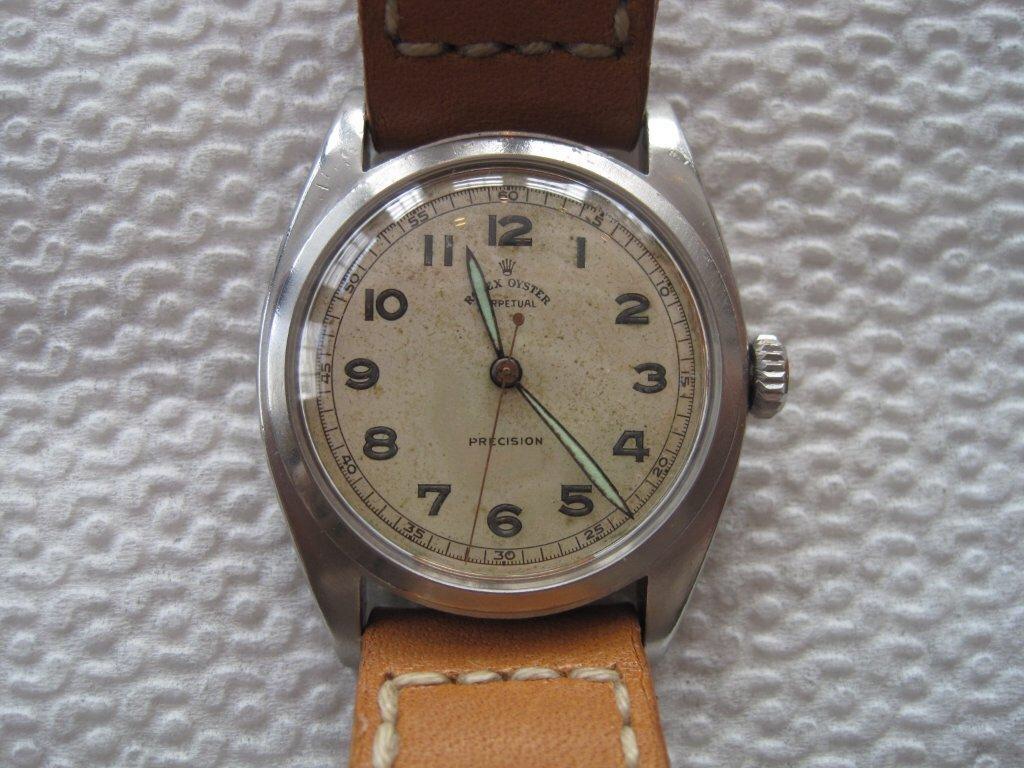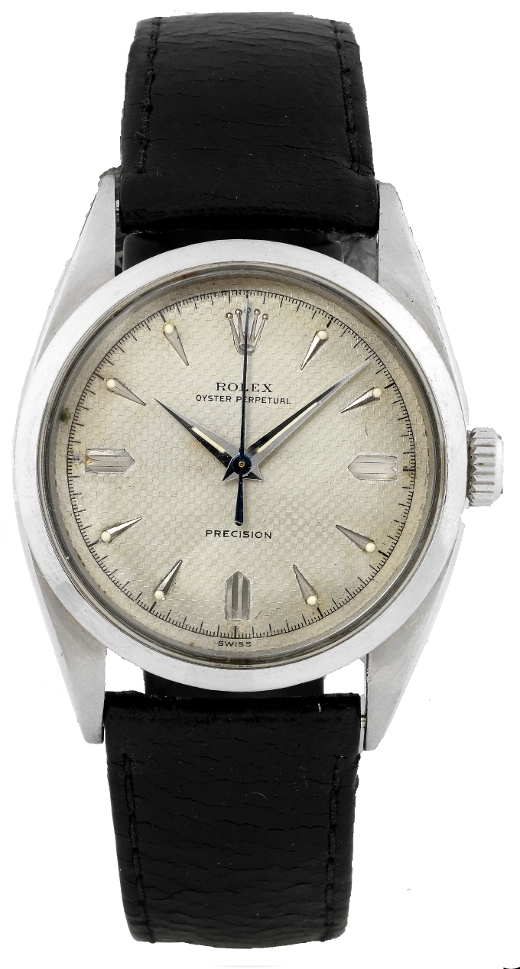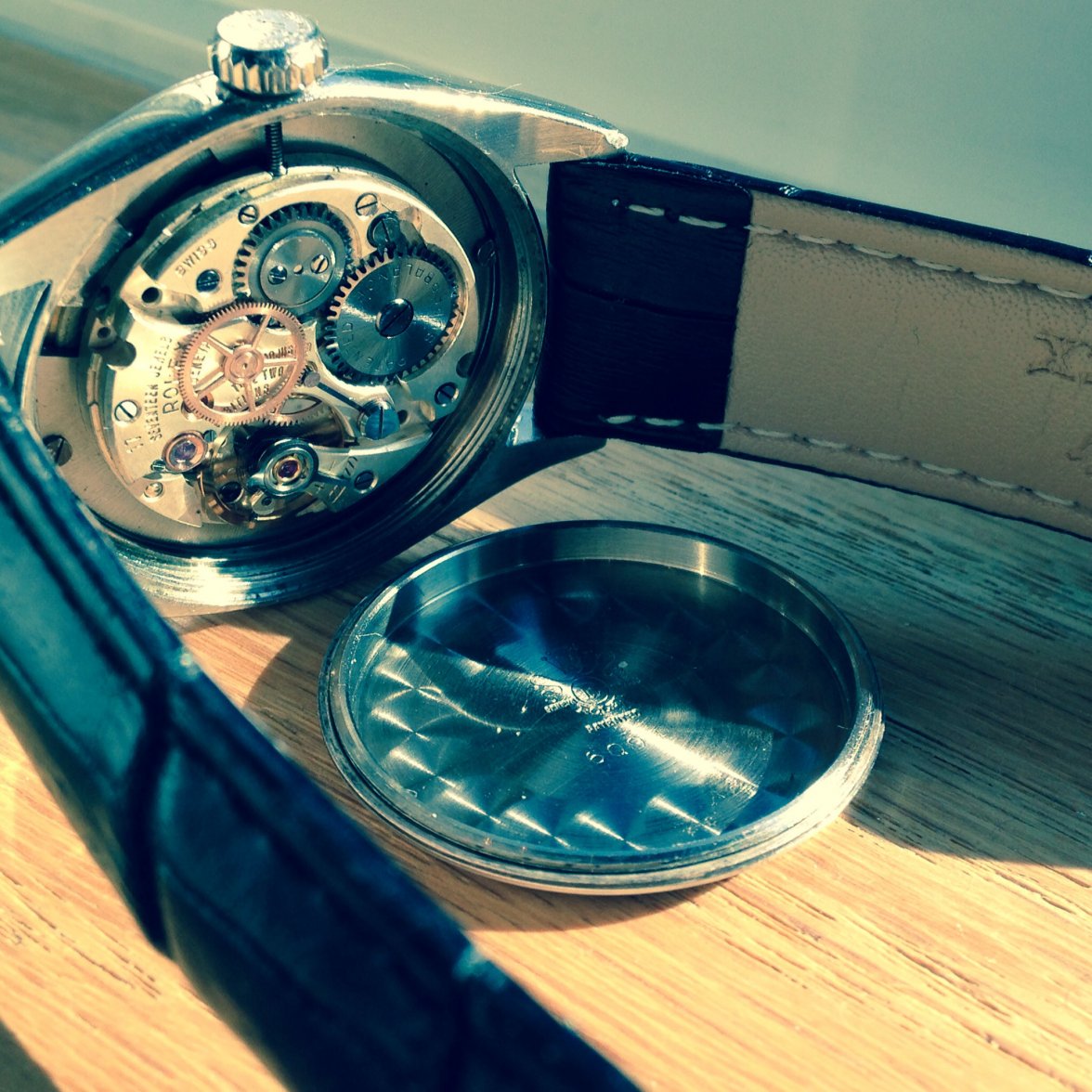real dial or a redial of this 1950s Rolex ?
kyle L
··GrasshopperLooks nice 😀
pitpro
·it's fine, original, radium burn surrounding the lume dots.
looks like a 6084 circa1953
these were a precursor step in the evolution of the Explorer line.
hands might have been redone but who cares
looks like a 6084 circa1953
these were a precursor step in the evolution of the Explorer line.
hands might have been redone but who cares
adam78
··Adam @ ΩFDarlinboy
··Pratts! Will I B******S!!!Very nice example. Buy it before I find out where it is for sale. [emoji16]
pitpro
·I'm pretty sure it's a 6084. Although I now think I'm off on the year.
More likely 1951. Notice your 6018 has different lugs.
After the 6084 came the 6098 then the 6298. All 3 could have had this type
of sunken numeral, Explorer type dial. But the 6098 and 6298 had the
words Explorer on them when in this configuration, usually. But, as I said
these were the first iteration of the Rolex Explorer line, which got the name
when Sir Edmund Hillary wore one on the first ascent of Mt Everest.
Here's another similar 6084

Edited:
adam78
··Adam @ ΩFpitpro
·Yes, the 6018 is one of the "bombé" models. I don't think this dial configuration is specific to any particular case reference. My 6094 Oysterdate has a similar one, too:
just referenced your 6018 in the post which is right above mine and it had the same type dial.
I was making a point on the lineage of the Rolex Explorer and these dials were part of the
progenesis of the Explorer line. Rolex was experimenting with many dial types at this stage
in both references..
The 6098 was the prototype and the 6298 was the update to that prototype in the development
of a more robust cased watch, both references are scarce. Both these references participated in the Sir Edmund Hillary
Mt. Everest ascent and other expeditions of the time. The ascent was March 1953 and I believe the
common thinking is that Explorer made it onto the dial 4-5 months later.
Now that I am looking at the crown on the OP's picture, I think there's a good chance it could be a 6098 or 6298.
Somebody ought to grab it if resonably priced
Sir Edmund Hillary's 6084 (from an earlier expedition)
Here's some 6098's
Here's some 6298's
Sir Edmund Hillary's supposed Everest watch( some say he wore a Smith's)
other 6298's
mine:bought from E.Ku
Edited:
LarryG
·LarryG
·By the by, Explorer was registered a few months before (Everest was conquered), in January of '53.
pitpro
·By the by, Explorer was registered a few months before (Everest was conquered), in January of '53.
that's what I would call the consensus the way I remember. I'm a 53 baby and
this one is my birth year watch so I got quite into the whole thing at one time a
few years back. The 6150 also figures into this whole story but for the sake
of keeping the post from getting ridiculously long...
pitpro
·LarryG
·Yeah, that's stunning. And from what Ive read, you're right, Explorer appeared on dial after the ascent.
They're underappeciated, althugh Ive seen some recenty trade at healthy prices.
They're underappeciated, althugh Ive seen some recenty trade at healthy prices.
citizenrich
·Greetings, fellow 6094'er...
I bought this one at a Pawn Shop in North Carolina on a drive home to NYC from Atlanta.
I was (((psyched))) when I discovered it was a really early serial number (low 7xx) which makes it one of the first few hundred oysters in existence. I stroked a nice extra base hit on this one which more than makes up for some of my (((whiff's))). Lulzzzzzz
I bought this one at a Pawn Shop in North Carolina on a drive home to NYC from Atlanta.
I was (((psyched))) when I discovered it was a really early serial number (low 7xx) which makes it one of the first few hundred oysters in existence. I stroked a nice extra base hit on this one which more than makes up for some of my (((whiff's))). Lulzzzzzz
Edited:
Canuck
·Once upon a time, I owned an Oyster Explorer which came from my late father who was the second owner. A friend of mine now has the watch, and I am trying to get in touch with him so I will have a picture of it. This particular watch is likely from the 1940s, and is from an era when the "sister" line to Rolex was Oyster, not Tudor. So Rolex has toyed with the Explorer name during an era prior to Hillary climbing Everest. I'll post a picture when I have it. It is the earliest example of an Explorer that I have ever seen.
Drawarms
·looks good mate!
Vintage Luxury
·Yes it is fine, a very nice piece of story, the precursor of the Explorer as written by PitPro
pitpro
·From Christies-
The Field Testing
Rolex began testing its watches in the 1920s amid all manner of extreme pursuits: In 1927, Mercedes Gleitze was supplied a newly-introduced Oyster for her attempt to repeat her swim across the English Channel (she quit after more than 10 hours in cold water; her Rolex didn’t); from 1927-1936, Sir Malcolm Campbell set nine land speed records wearing an Oyster; Rolexes were also worn by pilots setting long distance flying records in the late 1930s, and in establishing the 1955 record for “a double crossing of the Atlantic by a small boat under power.” The publicity was priceless but the feedback from these wearers was paramount.
©
The Conquest
Rolex was heavily involved in polar and alpine conquests, from which the watchmaker learned a good deal that ultimately informed its Explorer line. For example, the Oyster case was strengthened to endure extreme pressures. Rolex supplied (or touted the use of privately purchased) Oyster watches that accompanied no fewer than 15 Himalayan and Indian expeditions between 1933 and 1953. Most notable was the summit of Mount Everest on May 29 1953 by a British-led expedition. At least one Oyster Perpetual chronometer (likely a 6084 or 6098) accompanied Sir Edmund Hillary and Sherpa Tenzing Norgay to the world’s highest point.
The Promotion
Three days after conquering Everest, the British crowned a new queen. Several months later, an ad in the November 1953 issue of Horological Journal announced: “The New Elizabethan Age Heralds a New Rolex Triumph. A watch to measure the adventurous hours of the new reign. The watch has been called the Rolex ‘Explorer,’ and it has been designed to withstand every conceivable hazard.” Touting Arctic oil lubricant (guaranteed fluidity to -40 F), antimagnetic qualities, and the legibility of its 3-6-9 dial, the ad boasted that the watch would "function perfectly under water to depths of at least 300 ft, and in the air to the fantastic height of 12 miles.”
The Name
The Horological Journal ad went on to note that the Explorer, specifically, had been “tested on several recent Arctic Expeditions.” Rolex had registered the name “Explorer” on January 26, 1953—four months before the successful Everest summit. But none of those expedition-supplied Rolexes (“Bubbleback” references 6084 and 6098) bore the Explorer name. It's unknown exactly when the word “Explorer” first appeared on dials, but Rolex definitely sought to connect the watch with its Everest participation. The multitude of Explorer references created following Hillary and Tenzing’s success have been linked to that singular event ever since.
The Lineage
This 1016 became the unmistakable Explorer standard but it took some time. Despite Rolex’s popularity in 1953 and the magnitude of the Everest achievement, the company wasn’t sure how to position its new Explorer. So it experimented. Examples include: dials with 3-6-9 configuration but without the “Explorer” signature (others had the reverse); chronometer and non-chronometer dials; time-only and date versions; Air King Explorers; white, champagne, and black honeycomb dials; and even 3-6-9 dials signed “Everest”. Very rare hybrids place the 3-6-9 Explorer-style dial (minus the word “Explorer”) on a 5512 or 5513 Submariner.
The Field Testing
Rolex began testing its watches in the 1920s amid all manner of extreme pursuits: In 1927, Mercedes Gleitze was supplied a newly-introduced Oyster for her attempt to repeat her swim across the English Channel (she quit after more than 10 hours in cold water; her Rolex didn’t); from 1927-1936, Sir Malcolm Campbell set nine land speed records wearing an Oyster; Rolexes were also worn by pilots setting long distance flying records in the late 1930s, and in establishing the 1955 record for “a double crossing of the Atlantic by a small boat under power.” The publicity was priceless but the feedback from these wearers was paramount.
©
The Conquest
Rolex was heavily involved in polar and alpine conquests, from which the watchmaker learned a good deal that ultimately informed its Explorer line. For example, the Oyster case was strengthened to endure extreme pressures. Rolex supplied (or touted the use of privately purchased) Oyster watches that accompanied no fewer than 15 Himalayan and Indian expeditions between 1933 and 1953. Most notable was the summit of Mount Everest on May 29 1953 by a British-led expedition. At least one Oyster Perpetual chronometer (likely a 6084 or 6098) accompanied Sir Edmund Hillary and Sherpa Tenzing Norgay to the world’s highest point.
The Promotion
Three days after conquering Everest, the British crowned a new queen. Several months later, an ad in the November 1953 issue of Horological Journal announced: “The New Elizabethan Age Heralds a New Rolex Triumph. A watch to measure the adventurous hours of the new reign. The watch has been called the Rolex ‘Explorer,’ and it has been designed to withstand every conceivable hazard.” Touting Arctic oil lubricant (guaranteed fluidity to -40 F), antimagnetic qualities, and the legibility of its 3-6-9 dial, the ad boasted that the watch would "function perfectly under water to depths of at least 300 ft, and in the air to the fantastic height of 12 miles.”
The Name
The Horological Journal ad went on to note that the Explorer, specifically, had been “tested on several recent Arctic Expeditions.” Rolex had registered the name “Explorer” on January 26, 1953—four months before the successful Everest summit. But none of those expedition-supplied Rolexes (“Bubbleback” references 6084 and 6098) bore the Explorer name. It's unknown exactly when the word “Explorer” first appeared on dials, but Rolex definitely sought to connect the watch with its Everest participation. The multitude of Explorer references created following Hillary and Tenzing’s success have been linked to that singular event ever since.
The Lineage
This 1016 became the unmistakable Explorer standard but it took some time. Despite Rolex’s popularity in 1953 and the magnitude of the Everest achievement, the company wasn’t sure how to position its new Explorer. So it experimented. Examples include: dials with 3-6-9 configuration but without the “Explorer” signature (others had the reverse); chronometer and non-chronometer dials; time-only and date versions; Air King Explorers; white, champagne, and black honeycomb dials; and even 3-6-9 dials signed “Everest”. Very rare hybrids place the 3-6-9 Explorer-style dial (minus the word “Explorer”) on a 5512 or 5513 Submariner.
Canuck
·I finally have a picture of that Explorer I mentioned in an earlier post. Unfortunately, it is not a great picture, but it is what the owner sent me. This one is an Oyster Explorer, not a Rolex. It is from an era when Oyster, not Tudor, was the companion line to Rolex. The case serial number shown in the image indicates circa 1943, according to the serial number/date tables I referenced. The movement is the caliber 59 which is
a Font movement. The case is a Swiss Oyster case. The Rolex bracelet is off a 1950s vintage Tudor, lug ends modified to fit the Explorer.
Edited:



